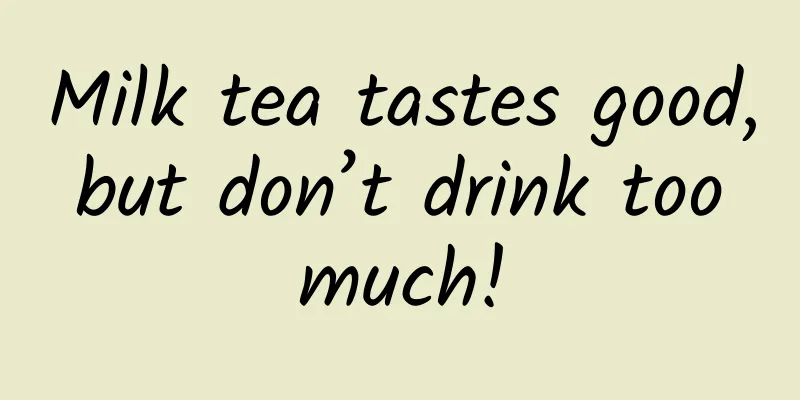Milk tea tastes good, but don’t drink too much!

|
Milk tea, as the name suggests, is a drink made by mixing milk and tea. Tea originated in China, but people in the plains of China have always preferred to drink "clear tea" or "pure tea". During the Yuan Dynasty, ethnic minorities in my country, such as the Mongolians, gradually discovered that boiling milk and tea together could produce milk tea with a unique flavor, which not only adapted to the living environment of the Mongolian Plateau, but also satisfied the material and spiritual enjoyment of herders [1]. Similarly, on the other side of the ocean, Britain, which was in its heyday in the 16th and 17th centuries, gradually developed a tradition of drinking milk tea due to the rough tea-making process and bitter taste, using milk to cover up the bitter taste of "pure tea" and increase the drinkability of the drink. In short, milk tea has been widely circulated in China and the West for hundreds of years, and has been passed down and developed to this day. The picture comes from the Internet With the improvement of people's living standards and consumption capacity, milk tea is loved by more and more consumers, especially young consumers, and the sales of milk tea companies in my country are increasing year by year. During this period, people found that the cost of making milk tea with whole milk is very expensive, which greatly limits the spread of milk tea among consumers. However, the use of food additives such as non-dairy creamer can produce a drink with the same taste as milk tea made with milk or even better, and can greatly reduce the cost of milk tea, which also promotes the circulation of milk tea in the market. However, many consumers are not satisfied with this. They think that what I want to drink is milk tea made of milk and tea, but how come what I drink in the end is a mixture of a bunch of additives? Are these additives harmful to my body? Can I still drink milk tea happily? The picture comes from the Internet Because of this, the safety of milk tea has always been a concern for our consumers. At present, the main safety issues criticized by people for milk tea are: milk tea contains caffeine, trans fatty acids, flavors and a lot of sugar. Will these affect our health? Next, we will gradually understand the safety knowledge behind milk tea. First of all, it is very normal for milk tea to contain caffeine. Because tea leaves contain a certain amount of caffeine, the caffeine content in dry tea leaves is generally between 2% and 4%, and the better the tea, the higher the caffeine content[2]. This also shows that the caffeine content in milk tea depends on the variety of tea and the strength of the tea during the production process. As long as caffeine is not consumed excessively every day, it will not cause harm to human health. It is generally believed that consuming less than 400 mg of caffeine a day will not have a negative impact on human health. There is also evidence that moderate amounts of caffeine can also reduce the risk of obesity, diabetes and cancer[3]. It can be seen that it is not surprising that milk tea contains caffeine. This just shows that milk tea really contains tea ingredients, and we don’t need to panic about this. However, since infants and young children are very sensitive to caffeine, it also reminds us that infants and young children should not drink caffeinated beverages including milk tea. Secondly, many milk teas on the market are not entirely made of milk and tea. They also contain several parts of milk tea that are prepared with additives such as creamer (non-dairy creamer). This depends on the price of the milk tea. Generally, the higher the price, the more "real milk" there may be in the milk tea. You don't have to panic or get angry when you see this, because non-dairy creamer is a legal food additive in my country. It is mainly made of vegetable oil, protein, and starch syrup as the main raw materials, and emulsifiers, thickeners, stabilizers, flavoring agents and other auxiliary materials are added. It uses microcapsule embedding technology and is processed into a powdered product through emulsification, homogenization, spray drying and other processes. It is a type of microencapsulated powdered oil. It can be seen that non-dairy creamer is actually an imitation dairy product with similar sensory qualities to milk powder. It can be added to other foods instead of milk powder to improve the nutritional value of the product and increase the flavor of the product. It was mainly used in coffee in the early days. A common formula of vegetable fat powder is: hydrogenated vegetable oil, glucose syrup, sodium caseinate and sodium aluminosilicate, among which sodium caseinate is an emulsifier and sodium aluminosilicate is an anti-caking agent. The amount added is small and basically harmless to the human body. The trans fatty acids that everyone has been worried about may appear in hydrogenated vegetable oil, which is only partially hydrogenated and does not contain a high content of trans fatty acids. According to data from the US Department of Agriculture and my country's survey data, the average content of trans fatty acids in milk tea is less than 0.41g/100g. In 2003, the World Health Organization recommended that the daily energy supply ratio of trans fats should be less than 1% (Note: the functional ratio of trans fatty acids refers to the percentage of energy provided by trans fatty acids in the total dietary energy). According to surveys, the energy supply ratio of trans fatty acids in most parts of my country is less than 0.3% [4]. If converted based on the basic energy value of 8,400 kilojoules required by adults per day, it is equivalent to a daily intake of no more than 2.2 grams of trans fatty acids [5]. From this we can see that, excluding the trans fatty acids that we may ingest in our daily diet, even if we drink a cup of 300-400ml milk tea every day, our health will not be affected by trans fatty acids. We know that the sources of trans fatty acids in our daily lives mainly include partial hydrogenation of oils and fats; oils and fats produced during the refining and deodorization process; and fats and milk fats of ruminants and vegetable oils produced during processing and cooking. It can be seen that we cannot avoid consuming trans fatty acids in our daily lives. As long as we control the amount of milk tea we drink every day, we don’t need to worry about the trans fatty acids in it. What’s more, the production process of non-dairy creamer has been gradually optimized, and the content of trans fatty acids in non-dairy creamer can be controlled to a very low level, or even zero trans fatty acids, so the impact of trans fatty acids can be ignored. Flavors are also a substance that we have always criticized in milk tea. In fact, flavors are widely used in food. In addition to the 28 kinds of food listed in my country's additive use standard (GB/T 2760-2014), other flavors can be added as needed. The functions of food flavors are mainly manifested in two aspects: one is to provide flavor for food. The second is to supplement and improve the flavor of food [6]. Due to its fast-moving nature, milk tea lacks flavor during the production process. Adding some flavors can make us feel more enjoyable. Moreover, flavors have the characteristic of "self-limitation" when used. When the amount of flavor added exceeds a certain range, its flavor will have the opposite effect and make people feel uncomfortable. Users have to reduce the amount to an appropriate range, which also avoids the safety problems that may arise from random additions. In fact, the most neglected thing about milk tea may be the sugar content. Generally, in order to achieve a better taste, a large amount of white sugar is added to milk tea. This sugar will enter our body while we drink milk tea, causing our daily sugar and total energy intake to exceed the standard without knowing it, which will have an impact on our body. Some scholars have conducted epidemiological research on the relationship between the consumption of sugary drinks and obesity in children and adults, two groups of people who consume more sugary drinks. After a long period of follow-up investigation, it was found that there is a clear positive correlation between the two. It is generally believed that the more sugary drinks a person consumes during childhood or adolescence, the more weight they gain in adulthood, which leads to obesity. People who drink large amounts of sugary drinks over a long period of time will gain weight and have a higher risk of diabetes, metabolic syndrome, gout, etc. This is mainly because high sugar levels can easily lead to weight gain, insulin resistance, β-cell dysfunction, inflammation, hypertension and other symptoms, which ultimately lead to the occurrence of some diseases [7]. Therefore, we must be careful when drinking high-sugar milk tea. Some people may say that many milk teas are sugar-free now, and the amount of white sugar added is very low. However, the price of sugar-free is to use some sweeteners such as saccharin and sodium cyclamate to replace white sugar. Although these sweeteners do not have safety issues, the taste of milk tea may change. The taste of sugar substitutes is still different from that of white sugar. Secondly, when we drink sugar-free milk tea without worry, it is easy to drink too much, and other substances in milk tea will stretch out their claws in excessive amounts, which will also affect our health. Milk tea is a very delicious drink. If conditions permit, drinking milk tea made with real milk is definitely better for the body, but there is no need to panic about milk tea made with creamer and other additives. Drinking it occasionally will not harm the body. In short, milk tea tastes good, but don't drink too much! References: 1. Zhang Linger. Inheritance and innovation of Mongolian milk tea culture[D]. Inner Mongolia Normal University, 2014. 2. Li Fanshu, Zhang Huanli, Ma Hui, et al. Extraction of caffeine from different teas[J]. Agricultural Products Processing, 2016(16):33-35. 3. Liu Hanyang, Zhou Yan, Gong Yu, et al. Research progress of caffeine in obesity, diabetes and tumors[J]. Medical Review, 2016, 22(5):928-932. 4. Ruan Guangfeng. Creamer does not equal trans fatty acids[J]. Health Expo, 2015(12):53-53. 5. Jason Guo, what are the ingredients of milk and tea in milk tea? Are they harmful to the human body? What are the ingredients of milk and tea in milk tea? Are they harmful to the human body? 6. Sun Baoguo, Tian Hongyu, Liu Yuping, et al. Effects of food flavors and fragrances on food safety[J]. Modern Scientific Instruments, 2006, 16(1):49-51. 7.Malik VS, Popkin BM, Bray GA, et al. Sugar-Sweetened Beverages, Obesity, Type 2 Diabetes Mellitus, and Cardiovascular Disease Risk[J]. Circulation, 2010, 121(11):1356-1364. |
Recommend
The most famous child psychology experiment in history: The overlooked side of "delayed gratification"
© Rochester Review/University of Rochester Leviat...
Inner Mongolia, Hebei and other 8 provinces and cities will face blowing sand or dust! Strong sandstorms are coming, please keep this defense manual
The Central Meteorological Observatory continued ...
The U.S. health department responded to Li’s refusal to take a test. She has been diagnosed but has been unsuccessful in trying to contact her many times!
On March 20, the Belmont Health Department in Mas...
[Smart Agriculture Diagram] One picture reveals the secret! How safe are genetically modified foods?
...
Douyin DTV advertising marketing value white paper!
Advertisers' marketing demands are constantly...
The iPhone is mediocre because Apple didn't put in the effort to research new patents
Apple has accelerated its layout in the field of ...
Online marketing solutions for the real estate industry!
The real estate industry is a typical highly cycl...
Thermos cup is a must-have in winter, how can you buy a safe one?
Now that the weather is getting colder, many peop...
Do your genes determine your life choices?
© The New York Times Leviathan Press: In recent y...
Don’t panic! These “abnormal physical examinations” are not diseases
Physical examination is an important channel for ...
Devil's Social Studies Ruan Qi "Core Confidence Course"
Devil's Social Studies Ruan Qi "Core Con...
The "magic medicine" in the drama is no longer hard to find? Sowing Tianshan Snow Lotus seeds on a 3,000-meter-high mountain!
Snow lotus grows near the snow line of the mounta...
The hot-selling "bare leg artifact" is actually a "modern torture device"? A 23-year-old girl got paronychia from being strangled...
The cold wind is blowing You who love beauty Have...
Alibaba Iron Army Sales Course Season 2: Find the first customer and earn the first million
The directory is as follows: 【Introduction】What c...
How to secretly take photos of me at work? This year's "Funny Wildlife Photo Award" is full of emojis!
It's Wednesday, does anyone want to go to wor...









